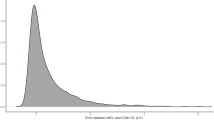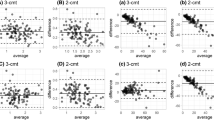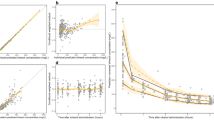Abstract
Background
Maximum a posteriori Bayesian estimation (MAP-BE) based on a limited sampling strategy and a population pharmacokinetic model is frequently used to estimate pharmacokinetic parameters in individuals, however with some uncertainty (bias). Recent works have shown that the performance in individual estimation or pharmacokinetic parameters can be improved by combining population pharmacokinetic and machine learning algorithms. Objective: The objective of this work was to investigate the use of a hybrid machine learning/population pharmacokinetic approach to improve individual iohexol clearance estimation.
Methods
The reference iohexol clearance values were derived from 500 simulated profiles (samples collected between 0.1 and 24.7 h) using a population pharmacokinetic model we recently developed in Monolix and obtained using all the concentration timepoints available. Xgboost and glmnet algorithms able to predict the error of MAP-BE clearance estimates based on a limited sampling strategy (0.1 h, 1 h, and 9 h) versus reference values were developed in a training subset (75%) and were evaluated in a testing subset (25%) and in 36 real patients.
Results
The MAP-BE limited sampling strategy estimated clearance was corrected by the machine learning predicted error leading to a decrease in root mean squared error by 29% and 24%, and in the percentage of profiles with the mean prediction error out of the ± 20% bias by 60% and 40% in the external validation dataset for the glmnet and Xgboost machine learning algorithms, respectively. These results were attributable to a decrease in the eta-shrinkage (shrinkage for a MAP-BE limited sampling strategy = 32.4%, glmnet = 18.2%, and Xgboost = 19.4% in the external dataset).
Conclusions
In conclusion, this hybrid algorithm represents a significant improvement in comparison to MAP-BE estimation alone.



Similar content being viewed by others
References
Leger F, Debord J, Le Meur Y, Rousseau A, Buchler M, Lachatre G, et al. Maximum a posteriori Bayesian estimation of oral cyclosporin pharmacokinetics in patients with stable renal transplants. Clin Pharmacokinet. 2002;41:71–80.
Marquet P, Destère A, Monchaud C, Rérolle J-P, Buchler M, Mazouz H, et al. Clinical pharmacokinetics and Bayesian estimators for the individual dose adjustment of a generic formulation of tacrolimus in adult kidney transplant recipients. Clin Pharmacokinet. 2021;60:611–22.
Guo W, Yu Z, Gao Y, Lan X, Zang Y, Yu P, et al. A machine learning model to predict risperidone active moiety concentration based on initial therapeutic drug monitoring. Front Psychiatry. 2021;12: 711868.
Woillard J, Labriffe M, Debord J, Marquet P. Tacrolimus exposure prediction using machine learning. Clin Pharmacol Ther. 2021;110:361–9.
Sibieude E, Khandelwal A, Girard P, Hesthaven JS, Terranova N. Population pharmacokinetic model selection assisted by machine learning. J Pharmacokinet Pharmacodyn. 2022;49:257–70.
Koch G, Pfister M, Daunhawer I, Wilbaux M, Wellmann S, Vogt JE. Pharmacometrics and machine learning partner to advance clinical data analysis. Clin Pharmacol Ther. 2020;107:926–33.
Tang B-H, Guan Z, Allegaert K, Wu Y-E, Manolis E, Leroux S, et al. Drug clearance in neonates: a combination of population pharmacokinetic modelling and machine learning approaches to improve individual prediction. Clin Pharmacokinet. 2021;60:1435–48.
Hughes JH, Keizer RJ. A hybrid machine learning/pharmacokinetic approach outperforms maximum a posteriori Bayesian estimation by selectively flattening model priors. CPT Pharmacometrics Syst Pharmacol. 2021;10:1150–60.
Baklouti S, Gandia P, Concordet D. “De-shrinking” EBEs: the solution for Bayesian therapeutic drug monitoring. Clin Pharmacokinet. 2022;61:749–57.
Åsberg A, Bjerre A, Almaas R, Luis-Lima S, Robertsen I, Salvador CL, et al. Measured GFR by utilizing population pharmacokinetic methods to determine iohexol clearance. Kidney Int Rep. 2020;5:189–98.
Benz-de Bretagne I, Le Guellec C, Halimi JM, Gatault P, Barbet C, Alnajjar A, et al. New sampling strategy using a Bayesian approach to assess iohexol clearance in kidney transplant recipients. Ther Drug Monit. 2012;34:289–97.
Taubert M, Ebert N, Martus P, van der Giet M, Fuhr U, Schaeffner E. Using a three-compartment model improves the estimation of iohexol clearance to assess glomerular filtration rate. Sci Rep. 2018;8:17723.
Taubert M, Schaeffner E, Martus P, van der Giet M, Fuhr U, Lösment A, et al. Advancement of pharmacokinetic models of iohexol in patients aged 70 years or older with impaired kidney function. Sci Rep. 2021;11:22656.
Salmon Gandonnière C, Helms J, Le Tilly O, Benz-de Bretagne I, Bretagnol A, Bodet-Contentin L, et al. Glomerular hyper- and hypofiltration during acute circulatory failure: iohexol-based gold-standard descriptive study. Crit Care Med. 2019;47:e623–9.
Woillard J-B, Salmon Gandonnière C, Destere A, Ehrmann S, Merdji H, Mathonnet A, et al. A machine learning approach to estimate the glomerular filtration rate in intensive care unit patients based on plasma iohexol concentrations and covariates. Clin Pharmacokinet. 2021;60:223–33.
Destere A, Gandonnière CS, Åsberg A, Loustaud-Ratti V, Carrier P, Ehrmann S, et al. A single Bayesian estimator for iohexol clearance estimation in ICU, liver failure and renal transplant patients. Br J Clin Pharmacol. 2021;88:15197.
SimulX version 2020R1. Antony: Lixoft SAS; 2019. http://lixoft.com/products/monolix/. Accessed 18 May 2022.
Kuhn M, Wickham H. Tidymodels: a collection of packages for modeling and machine learning using tidyverse principles. 2020. https://www.tidymodels.org. Accessed 18 May 2022.
Chen T, Guestrin C. XGBoost: a scalable tree boosting system. In: Proceedings of the 22nd ACM SIGKDD International Conference on Knowledge Discovery and Data Mining. San Francisco (CA): ACM; 2016: 785–94. https://doi.org/10.1145/2939672.2939785. Accessed 24 Dec 2021.
Friedman J, Hastie T, Tibshirani R. Regularization paths for generalized linear models via coordinate descent. J Stat Softw. 2010;33:1–22.
Monolix version 2018R1. Antony: Lixoft SAS; 2018. http://lixoft.com/products/monolix/. Accessed 18 May 2022.
Woillard J, Labriffe M, Debord J, Marquet P. Mycophenolic acid exposure prediction using machine learning. Clin Pharmacol Ther. 2021;110:370–9.
Acknowledgements
The authors acknowledge Karen Poole for her manuscript editing.
Author information
Authors and Affiliations
Corresponding author
Ethics declarations
Funding
No funding was received for the conduct of this study or the preparation of this article.
Conflicts of interest/competing interests
None of the authors has any conflicts of interest that are directly relevant to the content of this study.
Ethics approval
Ethics approval was obtained.
Consent to participate
The patients included in the validation set had participated in clinical trials for which they had given their consent and they signed informed consent regarding publishing their data.
Availability of data and material
The data that support the findings of this study can be obtained from Alexandre Destere on reasonable request (alexandre.destere@gmail.com).
Code availability
The code is available as Electronic Supplementary Material.
Author contributions
AD, JBW, PM, and AP contributed to the study conception and design. Material preparation and data collections were performed by CSG, AA, VLR, PC, SE, and CBLG and the analysis was conducted by AD and JBW The first draft of the manuscript was written by AD, JBW, and PM and all authors read and commented on the previous versions of the manuscript.
Supplementary Information
Below is the link to the electronic supplementary material.
Rights and permissions
About this article
Cite this article
Destere, A., Marquet, P., Gandonnière, C.S. et al. A Hybrid Model Associating Population Pharmacokinetics with Machine Learning: A Case Study with Iohexol Clearance Estimation. Clin Pharmacokinet 61, 1157–1165 (2022). https://doi.org/10.1007/s40262-022-01138-x
Accepted:
Published:
Issue Date:
DOI: https://doi.org/10.1007/s40262-022-01138-x




